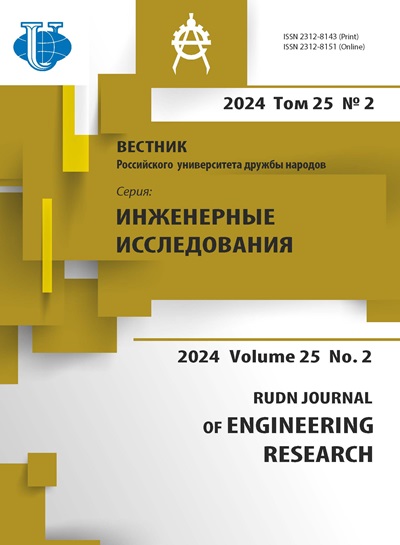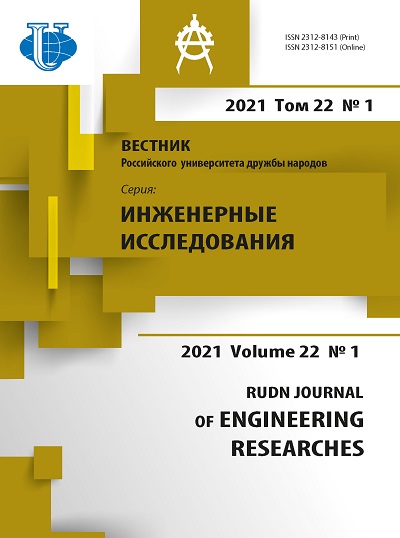Псевдосферические оболочки в строительстве
- Авторы: Жиль-улбе М.1, Ндомилеп И.Д.1, Нганду П.1
-
Учреждения:
- Российский университет дружбы народов
- Выпуск: Том 22, № 1 (2021)
- Страницы: 84-99
- Раздел: Статьи
- URL: https://journals.rudn.ru/engineering-researches/article/view/27260
- DOI: https://doi.org/10.22363/2312-8143-2021-22-1-84-99
Цитировать
Полный текст
Аннотация
Архитекторы, работающие с оболочкой, используют в своих проектах хорошо зарекомендовавшие себя геометрические формы, которые составляют около 5-10% от числа известных поверхностей. Однако есть такая известная поверхность вращения, которая с XIX в. по настоящее время пользуется большой популярностью среди математиков-геометров, но практически неизвестна архитекторам и дизайнерам, нет примеров ее применения в строительной отрасли. Это поверхность псевдосферы. Для псевдосферической поверхности гауссова кривизна во всех точках равна постоянному отрицательному числу. Псевдосфера, или поверхность Бельтрами, образуется вращением трактрисы. Псевдосфера, или поверхность Бельтрами, образуется вращением трассерсиса, эволюционирующего из цепной линии. В статье дается обзор известных методов расчета псевдосферических оболочек и исследуется напряженно-деформированное состояние тонких оболочек вращения с близкими геометрическими параметрами для определения оптимальных форм. Как отмечалось ранее, в научно-технической литературе не найдены примеры применения поверхности псевдосферы в строительной отрасли. Только Кеннет Бехер представил примеры псевдосфер, реализованных в природе: гипсовая модель псевдосферы, сделанная В. Мартином Шиллингом в конце XIX века.
Об авторах
Матье Жиль-улбе
Российский университет дружбы народов
Автор, ответственный за переписку.
Email: gil-oulbem@hotmail.com
ORCID iD: 0000-0003-0057-3485
доцент департамента строительства инженерной академии РУДН, кандидат технических наук
Российская Федерация, 117198, Москва, ул. Миклухо-Маклая, д. 6Ипел Джуниор Альфонс Ндомилеп
Российский университет дружбы народов
Email: ndomilepjunior@gmail.com
аспирант департамента строительства инженерной академии РУДН
Российская Федерация, 117198, Москва, ул. Миклухо-Маклая, д. 6Проспер Нганду
Российский университет дружбы народов
Email: prosperngandu60@gmail.com
магистрант департамента строительства инженерной академии РУДН
Российская Федерация, 117198, Москва, ул. Миклухо-Маклая, д. 6Список литературы
- Trinker AB. High-rise building in extremal conditions. Montazhnie i Spetz. Raboti v Stroitelstve. 2017;9:15-19.
- Esaulov GV. Modern problems and trends in architecture. Zhilischnoe Stroitelstvo. 2013;11:20-26.
- Krivoshapko SN. The History of Development of Architecture of Spatial Structures and Shells with Bases of Analysis. Moscow: RUDN; 2015. (In Russ.)
- Sysoeva EV. Scientific approaches to calculation and design of large-span structures. Vestnik MGSU [Proceedings of Moscow State University of Civil Engineering]. 2017;12,2(101):131- 141. (In Russ.) http://dx.doi.org/10.22227/1997-0935.2017.2.131-
- Krivoshapko SN. On application of parabolic shells of revolution in civil engineering in 2000-2017. Structural Mechanics of Engineering Constructions and Buildings. 2017;4:4-14. (In Russ.) http://dx.doi.org/10.22363/1815- 5235-2017-4-4-14
- Grinko EA. Review papers on geometry, strength, stability, dynamics, and applications of shells with middle surfaces of diverse classes. Montazhnie i Spetz. Raboti v Stroitelstve. 2012;2:15-21. (In Russ.)
- Mamieva IA, Razin AD. Symbol spatial structures in the form of conic surfaces. Promyshlennoe i Grazhdanskoe Stroitelstvo. 2017;10:5-11. (In Russ.)
- Krivoshapko SN. The application of conoid and cylindroid in forming of buildings and structures of shell type. Building and Reconstruction. 2017;5(73):34-44.
- Bandyopadhyay JN. Thin Shell Structures: Classical and Modern Analysis. New Age Int. Publ.; 1998.
- Krivoshapko SN. Static, vibration, and buckling analyses and applications to one-sheet hyperboloidal shells of revolution. Applied Mechanics Reviews. May 2002; 55(3):241- 270.
- Podgorniy AL, Grinko EA, Solovey NA. On research of new surface forms as applied to structures of diverse purpose. RUDN Journal of Engineering Researches, 2013;1:140-145. (In Russ.)
- Popov AG. Pseudospherical surfaces and some problems of mathematical physics. Fundamental and Applied Mathematics. Izd. Dom “Otkrytie Sistemy” (MGU). 2005;11(1):227-239.
- Brander D. Pseudospherical surfaces with singularities. Annali di Matematica Pura ed Applicata. June 2017;196(3):905-928.
- Dorfmeister JF, Sterling I. Pseudo-spherical surfaces of low differentiability. Advances in Geometry. 2013;16(1):1-20. http://dx.doi.org/10.1515/advgeom-2015-0039
- Coddington E. A Brief Account of the Historical Development of Pseudospherical Surfaces from 1827 to 1887.. Press of the New era printing Company, 1905, 74.
- Kaydasov Zh. On three types of bobbin-shaped surfaces. Dostizheniya Nauki i Obrasovaniya. 2018;1(23):6-8.
- Balazs NL, Voros A. Chaos on the pseudosphere. Physics Reports. 1986;143(3):109-240.
- Brecher K. Mathematics, Art and Science of the. Pseudosphere. In: Proceedings of Bridges 2013: Mathematics, Music, Art, Architecture, Culture. Netherlands, July 27-3, 2013. Amsterdam; 2013. p. 469-472.
- Ivanov VN, Krivoshapko SN. Analytical Methods of Analysis of Shells of Non-Canonical Shape: Monography. Moscow: RUDN; 2010.
- Rekach VG. Momentless theory of analysis of pseudospherical shells. Izv. Art. Inzh. Akademii, 1958; 109.
- Werner D. Ein Vergleich der Schnittkraftverteilung bei antimetrisch und symmtrisch belasteten Rotationsschalen. Wissenschaftliche Zeitschrift der Technischen Universität Dresden. 1967;16(4).
- Krivoshapko SN. Drop-shaped, catenoidal, and pseudospherical shells. Montazhnie i Spetz. Raboti v Stroitelstve, 1998;11-12:28-32.
- Bhattacharyya B. Shell-type foundation for R.C. Chimneys. Indian J. Power and River Valley Develop. 1982;32, 5-6:80-85.
- Filin AP. On the theory of general sphere and pseudospherical shells. Stroit. Mechanika i Raschet Sooruzheniy, 1990;5:43-46. (In Russ.)
- Mikheev AV. Local stability of pseudospherical orthotropic shells on the elastic base. Izvestiya SanktPeterburgskogo Gos. Elektrotechnicheskogo Universiteta LETI. 2013;7:9-15.
- Jasion P, Magnucki K. Buckling and post-buckling analysis of an untypical shells of revolution: Insights and Innovations in Structural Engineering, Mechanics and Computation. Proceedings of the 6th International Conference on Structural Engineering, Mechanics and Computation, SEMC 2016 6th. 2016:766-771.
- Jasion P, Magnucki K. Theoretical investigation of the strength and stability of special pseudospherical shells under external pressure. Thin-Walled Structures. 2015;93:88-93. http:// dx.doi.org/10.1016/j.tws.2015.03.012
- Krivoshapko SN, Emeliyanova YuV. To the question about the surface of revolution with geometrically optimal rise. Montazhnie i Spetz. Raboti v Stroitelstve. 2006;2:11-14. (In Russ.)
- Novozhilov VV, Chernyh KF, Mikhailovskiy EI. Lineynaya teoriya tonkih obolochek [Linear Theory of Thin Shells], Leningrad: Politehnika Publ.; 1991. (In Russ.)
- Kalashnikov AA. Calculation of spatial thin-wall designs in the shape pseudospherical surface. Structural Mechanics of Engineering Constructions and Buildings. 2005;2:35-40. (In Russ.)
- Kaydasov Zh. The pseudosphere with outer corrugations. Academy. 2018;3(30):3-5. (In Russ.)
- Krawczyk J. Infinitesimal isometric deformations of a pseudo-spherical shell. Journal of Mathematical Sciences. 2002;109(1):1312-1320. (In Russ.)
- Krivoshapko SN, Ivanov VN. Pseudospherical shells in building industry. Building and Reconstruction. 2018;2(76):32—40.
















